 W
WThe coat of arms of the Autonomous Republic of Adjara is a shield divided in two by a wavy line. In the center is a red smaller shield of the Lesser Arms of Georgia, bearing a silver horseman with a golden halo mounted on a silver horse and slaying a silver dragon with a golden-tipped, silver-shafted spear. The upper sector of the main shield bears a golden fortress on a green field and the lower one contains three golden coins on blue field.
 W
WThe emblem of Bhutan maintains several elements of the flag of Bhutan, with slightly different artistry, and contains much Buddhist symbolism.
 W
WThe Coat of arms of the London Borough of Brent is the official arms of the London Borough of Brent. It was granted on 1 September 1965.
 W
WThe coat of arms of the London Borough of Bromley is the official coat of arms of the London Borough of Bromley, granted on 20 April 1965.
 W
WThe coat of arms of Georgia is one of the national symbols of the republic. It is partially based on the medieval arms of the Georgian royal house and features Saint George, the traditional patron saint of Georgia. In addition to St. George, the original proposal included additional heraldic elements found on the royal seal, such as the seamless robe of Jesus, but this was deemed excessively religious and was not incorporated into the final version.
 W
WThe Regional Emblem of the Hong Kong Special Administrative Region of the People's Republic of China came into use on 1 July 1997, after the transfer of the sovereignty of Hong Kong from the United Kingdom to the People's Republic of China.
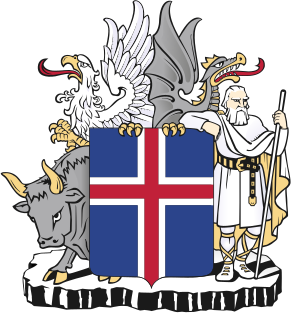 W
WThe coat of arms of Iceland displays a silver-edged, red cross on blue shield, alluding to the design of the flag of Iceland. It is the only national arms to feature four supporters: the four protectors of Iceland (landvættir) as described in Heimskringla, standing on a block of columnar basalt. The bull (Griðungur) is the protector of northwestern Iceland, the eagle or griffin (Gammur) protects northeastern Iceland, the dragon (Dreki) protects the southeastern part, and the rock-giant (Bergrisi) is the protector of southwestern Iceland. Great respect was given to these creatures of Iceland, so much that there was a law during the time of the Vikings that no ship should bear grimacing symbols when approaching Iceland. This was so the protectors would not be provoked unnecessarily.
 W
WThe coat of arms of Lancaster University is the official emblem of Lancaster University, in Lancashire, England. It was granted to the university by Royal Charter on its establishment in 1964.
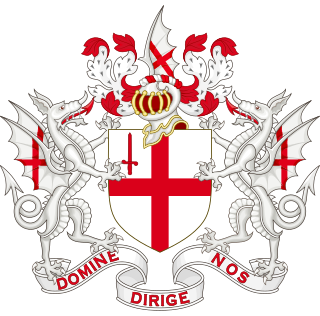 W
WThe coat of arms of the City of London is the official coat of arms of the City of London, which is one of a number of cities and boroughs in Greater London.
 W
WThe coat of arms of Melilla is that of the Ducal House of Medina Sidonia, whose titular funded the military operation that seized Melilla in 1497.
 W
WThe coat of arms of Moscow depicts a horseman with a spear in his hand slaying a basilisk and is identified with Saint George and the Dragon. The heraldic emblem of Moscow has been an integral part of the coat of arms of Russia since the 16th century.
 W
WThe coat of arms of Newport is the heraldic emblem of the city of Newport, South Wales. Also known as the Civic Badge, it has been borne by the present Newport City Council since 24 July 1996 following the municipal reorganisation in April that year.
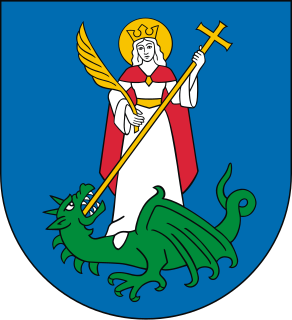 W
WThe coat of arms of Nowy Sącz in Poland shows Saint Margaret the Virgin, depicting the legend that she was swallowed by Satan, in the form of a dragon, who was however forced to spit her out again because the cross she was carrying irritated the dragon's innards. In Margaret's other hand is an olive branch, a symbol of peace.
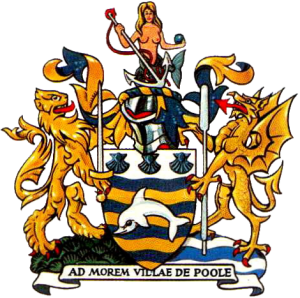 W
WThe coat of arms of Poole was first recorded by Clarenceux King of Arms during the heraldic visitation of Dorset in 1563. The arms were recorded again at the visitation of 1623, but neither visitation noted the colours of the arms. The design originated in a seal of the late 14th century and therefore predated the setting up of the College of Heralds in 1484 and also the order of King Henry V in 1417, which disallowed the bearing of arms without authority from the Crown.
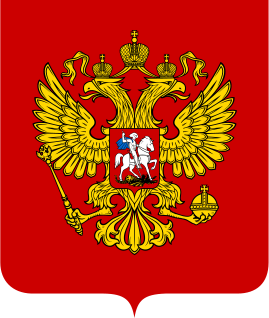 W
WThe coat of arms of Russia derives from the earlier coat of arms of the Russian Empire which was abolished with the Russian Revolution in 1917. Though modified more than once since the reign of Ivan III (1462–1505), the current coat of arms is directly derived from its medieval original, with the double-headed eagle having Byzantine and earlier antecedents. The general tincture corresponds to the early fifteenth-century standard.
 W
WThe Emblem of Sikkim, is currently used as the official seal of the Government of Sikkim, India. It was earlier used as the coat of arms of the House of Namgyal and the Kingdom of Sikkim. The emblem is known as the Kham-sum-wangdu. It was designed in 1877 by Robert Taylor.
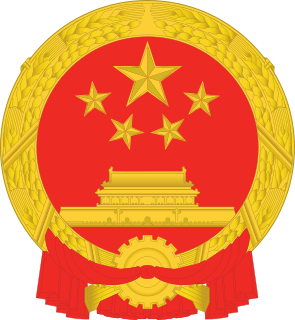 W
WThe National Emblem of the People's Republic of China contains in a red circle a representation of Tiananmen Gate, the entrance gate to the Forbidden City, where Mao Zedong declared the foundation of the People's Republic of China (PRC) in 1949. Above this representation are the five stars found on the national flag. The largest star represents the Communist Party of China, while the four smaller stars represent the four social classes as defined in Maoism. The emblem is described as being "composed of patterns of the national flag": ...The red color of the flag symbolizes revolution and the yellow color of the stars the golden brilliant rays radiating from the vast red land. The design of four smaller stars surrounding a bigger one signifies the unity of the Chinese people under the leadership of the Communist Party of China (CPC) —China Yearbook 2004
 W
WThe coat of arms of the Valencian Community is the official emblem of the self-government institutions of the Valencian Community. It is based on the armorial achievement used from the reign of King Peter IV to John II, called the Great. In 1978 the former Council of the Valencian Country approved it “...for being the oldest known representative emblem of the former Kingdom of Valencia, that had located on the Xerea Gate of the city of Valencia”.